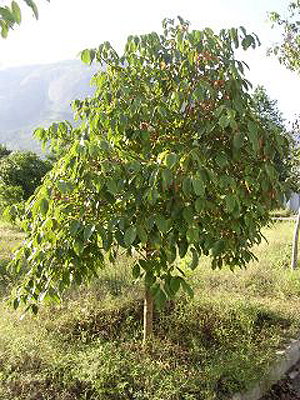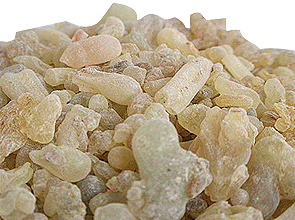



Boswella serrata Tree Boswellia Gum Resin
Boswellia serrata is a large, deciduous tree which grows abundantly in the dry, hilly parts of India. The gum resin of Boswellia serrata has been used in traditional Ayurvedic medicine for the management of rheumatism, respiratory diseases, and liver disorders. The major modern use of Boswellia serrata in modern herbalism is as an anti-arthritic and anti-inflammatory agent.
The anti-inflammatory properties of the boswellia gum resin are attributed to the presence of "boswellic acids".
Boswellia Inhibits Two Enzymes That Cause Inflammation
5-LOX (5-lipoxygenase). This enzyme generates inflammatory leukotrienes which are major promoters of inflammation and allergy processes. They are produced from arachidonic acid (an essential fatty acid synthesized in the body) by way of the 5-LOX enzyme pathway. Boswellic acids have been identified as inhibitors of 5-LOX. Therefore, they inhibit the production of inflammatory leukotrienes.
HLE (Human Leukocyte Elastase). HLE initiates injury to the connective tissues, which triggers the inflammatory process. Boswellic acids have been identified as inhibitors of HLE.
This dual inhibitory action on the inflammatory process is unique to boswellic acids.
The four major boswellic acids are called beta-boswellic acids. They are, in order of importance:
- acetyl-11-keto-ß-boswellic acid (AKBA)
- 11-keto-ß-boswellic acid (KBA)
- acetyl-ß-boswellic acid
- ß-boswellic acid
Studies on isolated, individual boswellic acid components show that only these four beta-boswellic acids are effective anti-inflammatory components.
Furthermore, tests show that acetyl-11-keto-ß-boswellic acid provides the most potent 5-LOX inhibitory action.
How To Read A Boswellia Extract Product Label
In the natural foods industry, the principal active constituents of Boswellia serrata are usually labeled as “boswellic acids.” Standardized extracts are typically labeled as containing about 50% to 70% boswellic acids. However, the labels on these products are inaccurate. That's because, without detailed HPLC analysis, the label claims of these products are actually referring to “total organic acids” and not to boswellic acids.
Also, many commercial products containing extracts of Boswellia serrata claim more than 50% total boswellic acids but they actually contain only negligible amounts of the two key boswellic acids: 11-keto-ß-boswellic acid (KBA) and acetyl-11-keto-ß-boswellic acid (AKBA) which are the more potent anti-inflammatory compounds.
How To Recognize The Most Effective Boswellia Extract
A truly highest-quality boswellia extract should contain at least 75% total boswellic acids and at least 50% beta-boswellic acids.
The label should show (by complete HPLC analysis) the content of each of the four primary beta-boswellic acids.
The extract should contain 30% acetyl-11-keto-ß-boswellic acid which has been shown to provide the most potent 5-LOX enzyme inhibition.
© 2009 IntraCell Nutrition Inc.